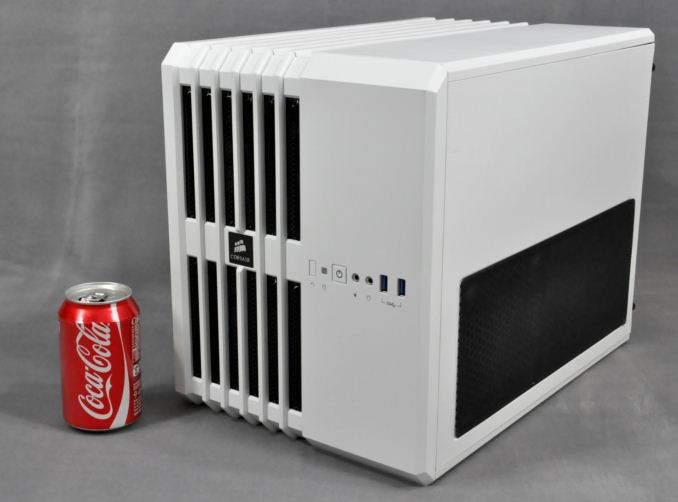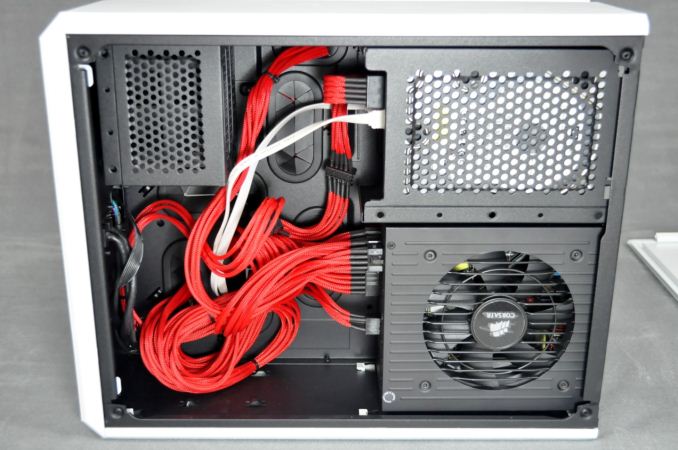Corsair Carbide Air 240 Case Review
by E. Fylladitakis on August 15, 2014 6:00 AM EST- Posted in
- Cases/Cooling/PSUs
- Corsair
- ATX
- Case
- Carbide
Conclusion
Aesthetically, the Carbide Air 240 is certainly eye-catching and very well designed. We cannot really claim that it is a unique case, both because many cubic cases are available and because it is based on the same external design as the Carbide Air 540, a case released over a year ago. However, this does not reduce the aesthetic value of the Carbide Air 240. Based on a minimalistic design of simple geometric shapes and grids, the Carbide Air 240 is a case that attracts attention without being extravagant. It is an understated, yet elegant design that ought to look great on any desk.
Due to its unorthodox shape, there are some limitations as well. For example, despite the width of the case, it is not possible to install very tall CPU coolers, leaving the end user to either settle for a smaller cooler or go for a liquid cooling solution instead. The large width is also going to be a problem for spaces and offices designed to hold standard tower cases, as the cubic Carbide Air 240 will obviously not fit.
One major weakness of the Carbide Air 240 is that there are no external drive slots, for 3.5" or 5.25" devices. Some advanced users have ditched optical media (never mind floppy disks and the like) a long time ago, but others still like to install a DVD-RW or Blu-ray drive. This severely limits the potential of the Carbide Air 240 to be used as a media center. However, that was never the intended purpose of this case, as it has obviously been designed to house little monster gaming PCs, not to function as an HTPC.
When it comes to performance, the Carbide Air 240 delivers as promised. It should easily be able to cover the thermal needs of even the most powerful gaming system that can fit inside it, even with the stock cooling setup if no overclocking takes place. For low-noise setups and overclocking, the installation of at least a good CPU cooler is highly recommended. If a Mini-ITX motherboard is installed, the installation of two liquid coolers, one for the CPU and one for the GPU respectively, can help to create a very powerful system with low operating noise. Unfortunately, due to space limitations, the installation of two GPUs and two liquid coolers does not seem possible, so it would be rather difficult to create a silent dual-GPU gaming system.
As far as quality goes, the Corsair Carbide Air 240 is a very well made product for its class. The plastics are solid and the mechanical cohesion of the chassis is very good as well. Our only complaint would concern the use of metallic meshes as dust filters. Although these metallic meshes are durable and convenient, they will not help with smaller dust particles at all. Furthermore, the panels need to come off in order to clean them, which is not very convenient. The mesh on the right side panel is an exception, as it is denser and can be cleaned very easily.
Recommending the Carbide Air 240 is easy enough, though as usual that depends on individual preferences. Aside from the fact that aesthetics are an entirely subjective matter, which is typically a major factor when it comes to choosing a case, the unorthodox design of the Carbide Air 240 is simply not meant for the majority of the users. Simply put, it is not a product meant for the average Joe to stick beneath an office desk and forget about it. Instead, this is a case meant to show off your powerful and yet compact gaming system, with an eye-catching cubic design. If that's what you're looking for, the Carbide Air 240 is definitely worthy of consideration. Pricing is reasonable as well, with both the white and the black models listed at Amazon and priced at $90 – $40 less than the larger Carbide Air 540.












63 Comments
View All Comments
HisDivineOrder - Sunday, August 17, 2014 - link
They take up too much space for too little gain. That space could be more 3.5" slots or even an open place for a fan.lexluthermiester - Wednesday, August 20, 2014 - link
Yup that's what he said. Wake up before you open your flap-trap.Etern205 - Friday, August 29, 2014 - link
I guess you haven't been old enough or encounter more, to know the nightmare it was to deal with external optical drives when they first arrived. I still remember when I had to use a external optical drive a few times to reinstall the OS on laptops where their internal optical drives had died or those that don't come with one. The problem is they're not that well built and the laptop itself as well as the bios also played a part.So this is what happens.
1. Not all USB ports plays nicely with USB optical drives, some will let it detect, but after a few minutes it mysteriously disconnects and then I had to power off the laptop and power it back on to let it find it again.
2. Some USB ports refuses to even detect any USB optical drives even after I changed to different brands, them USB cables, or even use one of those a internal optical drives connected via a SATA to USB adapter kit.
3. If I was lucky enough to begin the installation, I have to have my fingers crossed hoping the USB optical drive does not crap out during the middle of the installation and if it did, I have to restart the installation. The worst parts is finishing the installation up to 99% and then the USB optical drive craps out, so basically that's like a whole hour or so wasted for nothing.
4. Some laptops and USB optical drives have a mind of its own. they either want to work or don't work. With all these problems and weird behaviors, what used to be a simple install of the OS, has become a day of hell, just to get something that simple to complete, if their internal optical drive was working or it had one in the first place.
While they might have now improved, they had left a bad rep, therefore I still prefer a internal optical drive and cases should comes with at least one 5.25" bay. If you don't see the need to use a internal optical drive, then that 5.25" bay can be used for something else like adding a Hotswap SSD/HDD kit. or a LCD fan controller.
http://www.newegg.com/Product/Product.aspx?Item=N8...
I say Kill USB optical drives with fire and throw them stupid crap built laptops in alone with it.
Refuge - Friday, August 21, 2015 - link
I remember building in the 90's.To think external optical drives today are anything like the external drives of old, I guess you are just too old to build computers today?
Also back then, the simple work around was to take an internal drive, and just set it in the bottom of the case and hook it into the Mobo that way. I think you just lack imagination.
Kevin G - Friday, August 15, 2014 - link
I'll second the idea of additional 3.5" bays behind the motherboard. Also make them hot swap and then the case would be ideal for a DIY NAS or HTPC with redundant storage.lexluthermiester - Wednesday, August 20, 2014 - link
Totally with you!coburn_c - Friday, August 15, 2014 - link
Why do they ruin everything with garish plexy. Case windows should be an add-on option, industry wide.Infernus - Friday, August 15, 2014 - link
I agree, that's the only gripe I have with my 540 (and soon to be 240 when it eventually arrives).On a side note, I don't know why Apple doesn't offer the original NeXT Cube case in mATX/ATX format - I know I would pay good money for it.
notlurking - Friday, August 15, 2014 - link
Apple doesn't even have to do it! The NeXT Cube design patents expired years ago. I don't understand why, despite ten years of everyone saying they want a cube, that no manufacturer makes one. The next cube was 12"x12"x12" with a microATX sized motherboard, 1x3.5" bay and 1x5.25" bay.The 1x3.5" bay is need for SD slot or fan controller. Every laptop and All-in-one PC for the past ten years has had an SD slot yet only LianLi builds an SD slot in their case. The 1x5.25" bay is necessary because someone needs to do the rips that everyone else downloads.
Many people have bought NextCubes and modded them into PC's. I don't have time for modding but I'd pay for a 13"x13"x13" cube case.
The Carbide Air is so close to perfect, but I won't buy a 15.75" deep case that doesn't have a 5.25" bay.
zlandar - Friday, August 15, 2014 - link
The 12.4" height is too large to fit most entertainment consoles. My console has two fairly large shelves and the max height is 8.5". Not a ding since the author mentioned the case was not specifically designed for HTPC use but something to consider for people considering it.